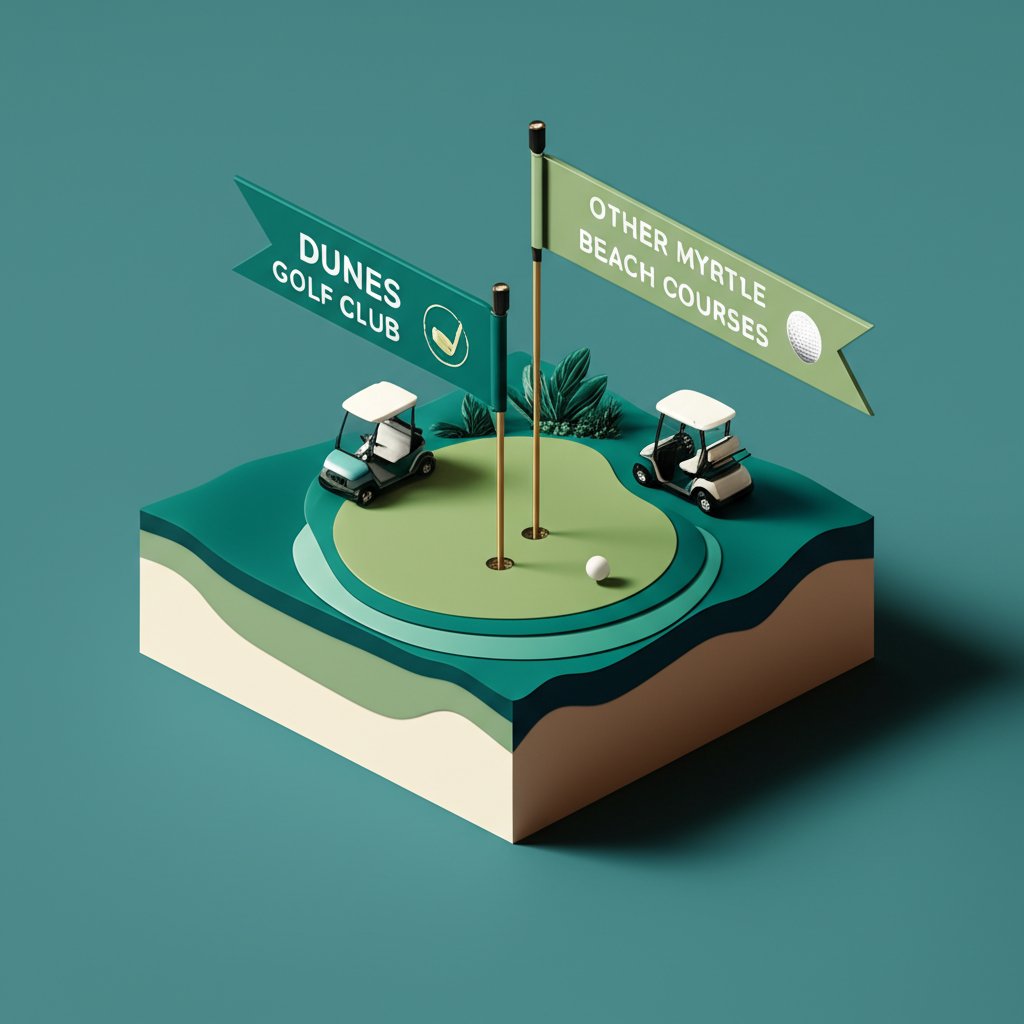For the discerning golfer, the quest for a course that transcends the ordinary leads invariably to a select few, and among them, The Dunes Golf and Beach Club in Myrtle Beach stands as a beacon of golfing excellence. This is not merely a place to play a round; it is an immersion into a legacy where the artistry of course design, the challenge of the game, and the serene beauty of the coastal landscape converge. It’s a journey into a storied past, a test of skill, and an unforgettable experience that etches itself into the memory long after the final putt drops.
The Enduring Legacy of Myrtle Beach’s Foremost Course
Myrtle Beach’s “Grand Strand,” a celebrated 70-mile stretch of coastline from Pawleys Island to Brunswick County, offers an abundant array of golf experiences. Yet, amidst this impressive collection of over 100 courses, The Dunes Golf and Beach Club consistently distinguishes itself as the premier destination for serious golfers. Its allure is multifaceted, blending historical significance with a challenging design that has captivated players for generations.
A Rich Tapestry Woven by Robert Trent Jones Sr.
Established in May of 1948, The Dunes Golf and Beach Club holds a unique place in the Grand Strand’s history, being only the second course to grace this renowned coastal strip. Its design was entrusted to a then-lesser-known architect named Robert Trent Jones Sr., who would later become one of the all-time greatest golf course architects. His genius is evident in every strategic contour and hazard, solidifying the club’s reputation as one of the finest golfing experiences in Myrtle Beach and the entire United States.
Jones Sr.’s design philosophy masterfully integrates the natural environment. While located barely more than a block from the Atlantic Ocean, the course defies a typical “seaside” or “links” classification. Instead, it features a captivating blend of woodland, parkland, and marshland elements. Majestic old oaks line many of the fairways, and water hazards, in the form of ponds and marshes, come into play on more than half the holes. The iconic 9th hole offers the lone, breathtaking glimpse of the Atlantic, a momentary visual reward amidst the strategic challenges.
Robert Trent Jones Sr.’s distinctive trademarks are also meticulously preserved throughout the 7,450-yard, par-72 championship layout. Golfers will encounter his signature runway tee boxes, providing expansive starting platforms, and a generous dose of strategically placed fairway bunkering, demanding precision and thoughtful shot placement. The elevated green complexes, often guarded by large and deep Augusta white sand bunkers, are particularly challenging. True to Jones’s design ethos, most holes present compelling risk-reward options: a safer path for an easier par, or a more aggressive line for a difficult birdie with the inherent risk of a much higher score. This intricate balance ensures a profound test of skill for seasoned professionals and an engaging challenge for enthusiastic amateurs.
A Benchmark of Golfing Excellence
Local PGA professionals, intimately familiar with the nuances of the Grand Strand’s diverse courses, consistently rank The Dunes Golf and Beach Club as the undisputed leader. This consensus is rooted in its challenging Robert Trent Jones Sr. design, which sets it apart from many public-access courses in the area. The strategic depth of holes like “Waterloo” and the revamped 18th hole offer a level of competitive play that few others can match. While courses like Caledonia Golf & Fish Club and True Blue Golf Club receive high praise for their unique attributes, The Dunes’ unparalleled blend of prestige and challenge often tips the scales for those seeking the ultimate golf experience. The Club’s long history as host to major championships, including the USGA Women’s Amateur Public Links Championship, the Senior PGA Tour Championship, the PGA Tour “Q-school,” and the prestigious 1962 Ladies US Open, is a testament to its enduring quality and championship pedigree.
Before planning your trip, consider the equally prestigious Miami Beach Golf Club.
Mastering “Waterloo”: A Step-by-Step Tactical Guide

The 13th hole at The Dunes Golf & Beach Club, known universally and respectfully as “Waterloo,” is not merely a par-5; it is an epic confrontation, a strategic puzzle designed by Robert Trent Jones to test the mettle of every golfer. Its reputation as one of the top golf holes in the U.S. is well-earned, having humbled countless players since its opening in 1949. This 590-yard par-5 in a crescent moon shape along the perimeter of Lake Singleton presents an unforgettable challenge. The presence of alligators in Lake Singleton adds a thrilling, albeit unnerving, natural element to this iconic test.
Navigating “Waterloo”: A Tactical Framework
Successfully conquering Waterloo requires a thoughtful, calculated approach that blends courage with prudence. Prepare for a battle of wits and precision against this renowned hole.
- The Tee Shot: Precision Over Power: A slice or push off the tee (for a right-handed golfer) will find the water. The longer the tee shot, the narrower the landing area becomes as the fairway hugs the lake. Conversely, a conservative tee shot leaves significantly longer, more challenging subsequent shots. The ideal tee shot is long enough to set up the next, but crucially, perfectly placed to avoid the watery menace to the right.
- The Second Shot: The Calculated Gamble: This is where Waterloo truly earns its name. Any thought of reaching the green in two requires an exceptionally long and audacious tee shot, followed by an equally bold second shot that attempts to cut off as much of Lake Singleton as daringly possible. Bite off more than you can chew, and your ball will be wet. Meet the challenge, and a possible birdie awaits, a profound sense of accomplishment for those who execute flawlessly.
- The Layup: Strategic Placement: For most players, a well-executed layup is the sensible play. The goal is to position the ball safely for a short third shot into the receptive green. However, even a layup requires careful consideration of the lake’s perimeter and the narrowing fairway.
- The Approach: Green Complex Insights: The elevated green complex at Waterloo, like others on the course, demands an accurate approach. Large bunkers strategically guard the green, ready to penalize any errant shots. A front pin position makes firing directly at the flag a particularly risky choice. Read the greens carefully; they uphold Jones’s reputation for challenging putting surfaces.
Beyond the Championship Course: Premier Amenities and Coastal Comforts

The Dunes Golf and Beach Club offers a comprehensive luxury experience that extends far beyond its celebrated golf course. This is a destination where recreation and relaxation intertwine seamlessly, catering to a refined clientele seeking an unparalleled coastal retreat.
The elegant clubhouse serves as the social heart of the club, a sophisticated hub for members and guests. It features a full-service restaurant that offers exquisite dining experiences, from casual lunches overlooking the course to fine-dining evenings. The welcoming bar is perfect for post-round reflections, social gatherings, or simply enjoying a refreshing beverage. A well-appointed pro shop is stocked with the latest golf apparel, equipment, and club-branded merchandise, ensuring golfers are perfectly outfitted.
For those seeking activities beyond golf, the club provides an impressive array of facilities. Eight pristine Har-Tru tennis courts, renowned for their comfortable playability and classic clay surface, invite players of all skill levels. A Junior Olympic-sized swimming pool offers a refreshing escape and a perfect setting for family enjoyment. Perhaps most exclusive is the private beach access area, providing members and guests with a serene and uncrowded stretch of Myrtle Beach coastline – a true hallmark of this premier coastal destination.
Modern Enhancements & Unique Features
While steeped in history, The Dunes Golf and Beach Club is also committed to continuous improvement, ensuring its facilities remain world-class. Since early in the new millennium, the club has engaged Rees Jones, son of the original designer, and his associate Steve Weisser, working alongside long-term superintendent Steve Hamilton, on significant course enhancements.
These improvements have been meticulously executed to restore the course’s original grandeur while integrating modern advancements. Greens have been brought back to their original size, offering greater pin positions and challenge. New tees have been introduced, enhancing playability for various skill levels and ensuring the course remains a contemporary test. A state-of-the-art irrigation system has been installed, contributing to the consistently well-manicured greens and rolling fairways for which the course is renowned.
Furthermore, every bunker on the course has been reviewed, rethought, and either relocated or rebuilt, with the installation of the advanced Better Billy Bunker liner throughout. As Rees Jones himself noted, “Every bunker has been rethought and relocated or rebuilt. We also carefully evaluated the depths of the bunkers. We’ve taken some fill away and cut them down into the surface.” This attention to detail ensures that the strategic bunkering remains a formidable yet fair challenge, enhancing the overall golf experience.
- Unforgettable: Talking Stick Golf Club Review – Desert Golfing Redefined - November 17, 2025
- Discover Talega Golf Club: Championship Golf & Spanish Hospitality Awaits! - November 15, 2025
- Is Strawberry Farms Golf Club Orange County’s Best Kept Secret? - November 13, 2025









